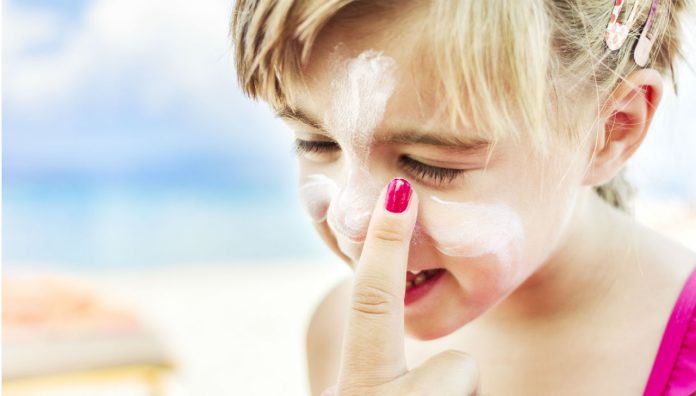Nanoparticles contained in sunscreen do not penetrate the skin or cause cellular toxicity, a new Australian study published in the Journal of Investigative Dermatology has shown.
The research, led by the University of Queensland (UQ) and University of South Australia (UniSA), provides the first direct evidence that concerns about the risks of nanoparticulate-based sunscreens have no basis. This refutes widespread claims among some public advocacy groups and consumers about their supposed dangers.
Lead investigator Michael Roberts, Professor of Therapeutics and Pharmaceutical Science at UniSA and Professor of Clinical Pharmacology and Therapeutics at UQ, says the myth about sunscreen toxicity surfaced after animal studies found much higher skin absorption of zinc-containing sunscreens than human studies.
‘There were concerns that these zinc oxide nanoparticles could be absorbed into the epidermis, with toxic consequences, including DNA damage,’ he said.
Methodology
Professor Roberts and his co-researchers in Brisbane, Adelaide, Perth and Germany studied the safety of repeated applications of zinc oxide (ZnO) nanoparticles, applied to five volunteers aged 20–30 years. The volunteers applied the ZnO nanoparticles every hour, for six hours on five consecutive days.
The study used state-of-the-art imaging with a multiphoton microscope, live and in vivo, to look at where these nanoparticles ended up. Furthermore, it evaluated quantitatively if there was any damage to the living cells underneath the area of application using Fluorescence Lifetime Imaging Microscopy (FLIM).
Findings
The authors established that the ZnO nanoparticles accumulated on the skin surface and within the skin furrows but did not enter or cause any cellular damage in the viable epidermis. The repeated application was associated with penetration of zinc ions into the skin, but this did not appear to cause local toxicity.1
Discussion
The study’s principal investigator, UQ’s Dr Yousuf Hussain Mohammed, said the results equip pharmacists to help Australians make better sun protection choices. He added, ‘As a result of our findings, we have now firmly settled the doubts about the safety of ZnO nanoparticles (NPs) in sunscreens that have been circulating for many years.’
Study authors claimed that proponents of a ban on NP sunscreens based their arguments on very flimsy scientific evidence that relied on sparse in vitro studies, most of which were performed artificially on the bench in well plates, with unprotected skin cells.
The proponents ‘also argued that the uniquely high surface area-to-volume ratio of NPs renders them inherently toxic.’ In the absence of evidence to support their case, they invoked the precautionary principle, which states that ‘if you have no proof that a product is safe then you shouldn’t use it,’ said Dr Mohammed.
In reality, however, the high surface-area-to-volume ratio allows them to be more effective in their job as scatterers of UV radiation, particularly when spread evenly over the skin surface in a well-designed formulation.
The main factor that opponents of NPs in sunscreens fail to recognise, is that human skin, even in children, imposes a formidable barrier that prevents penetration to exogenous substances we come into contact with, including nanoparticulate matter.
The study authors concluded that ‘we now have a large body of work accumulated over the last ten years, of which this latest publication is the culmination, that conclusively shows ZnO-NPs do not penetrate human skin under in-use conditions, and cause no toxicity to the underlying living cells.’
Also, recent studies have all been carried out on healthy human volunteers – looking at intact skin versus barrier impaired skin,2 the effects of massage and flexing,3 formulation and excipient effects,4 and the latest work looking at repeated daily and hourly exposure. This Australian study is relevant as the volunteers were everyday Australians.1
In conclusion, authors stated that ‘we are now very well informed about the safety of ZnO nanoparticle exposure, and can confidently state that the benefit of nanoparticulate sunscreens with ZnO far outweighs the perceived risks of skin and cell damage, which are not supported by scientific evidence.’
Hopefully the findings help improve consumer confidence in these products, and in turn this leads to better sun protection. The terrible consequences of skin cancer and skin damage caused by prolonged sun exposure are much greater than any toxicity posed by approved sunscreens.
References
- Mohammed YH, Holmes A, Haridass IN, Sanchez WY, Studier H, Grice JE, et al. Support for the safe use of zinc oxide nanoparticle sunscreens: lack of skin penetration or cellular toxicity after repeated application in volunteers. J Invest Dermatol 2018;138: 1-8.
- Leite-Silva VR, Sanchez WY, Studier H, Liu DC, Mohammed YH, Holmes AM, et al. Human skin penetration and local effects of topical nano zinc oxide after occlusion and barrier impairment. Eur J Pharm Biopharm 2016; 104:140-147.
- Leite-Silva VR, Liu DC, Sanchez WY, Studier H, Mohammed YH, Holmes A, et al. Effect of flexing and massage on in vivo human skin penetration and toxicity of zinc oxide nanoparticles. Nanomedicine (Lond) 2016; 11: 1193-1205.
- Leite-Silva VR, Lamer ML, Sanchez WY, Liu DC, Sanchez WH, Morrow I, et al. The effect of formulation on the penetration of coated and uncoated zinc oxide nanoparticles into the viable epidermis of human skin in vivo. Eur J Pharm Biopharm 2013; 84:297-308.



 John Jones MPS, pharmacist immuniser and owner of My Community Pharmacy Shortland in Newcastle, NSW[/caption]
John Jones MPS, pharmacist immuniser and owner of My Community Pharmacy Shortland in Newcastle, NSW[/caption]


 Debbie Rigby FPS explaining how to correctly use different inhaler devices[/caption]
Debbie Rigby FPS explaining how to correctly use different inhaler devices[/caption]




 Professor Sepehr Shakib[/caption]
Professor Sepehr Shakib[/caption]

 Lee McLennan MPS[/caption]
Lee McLennan MPS[/caption]
 Dr Natalie Soulsby FPS, Adv Prac Pharm[/caption]
Dr Natalie Soulsby FPS, Adv Prac Pharm[/caption]
 Joanne Gross MPS[/caption]
Joanne Gross MPS[/caption]








